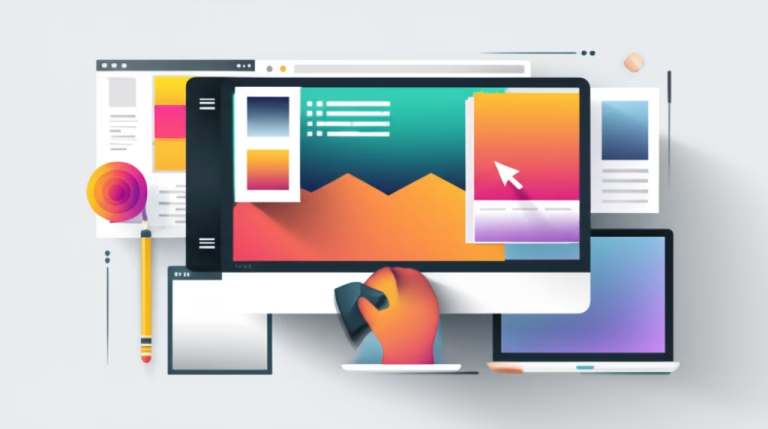How to Build Your Portfolio: A Beginner’s Guide
Introduction
Starting your design journey can feel overwhelming, especially when it comes to showcasing your work. You might be thinking, “I don’t have enough projects!” or “My work isn’t good enough yet.” That’s perfectly normal! This guide is designed to help you, a beginner designer, understand the importance of a strong portfolio and provide practical steps to build your portfolio, even if you’re just starting out. We’ll cover what a portfolio is, why it matters, essential principles, common mistakes, and a step-by-step process to create one that impresses.
Table of Contents
What is a Design Portfolio?
A design portfolio is a curated collection of your best work, presented in a way that highlights your skills, process, and design thinking. It’s essentially your professional resume for the visual world. Unlike a traditional resume that lists your experience, a portfolio visually demonstrates your abilities and style. It’s a dynamic representation of your growth as a designer and a powerful tool for landing jobs, internships, or freelance gigs. Think of it as your personal gallery, showcasing the best of what you can offer.
Why is a Portfolio Important in Design?
In the design world, a portfolio is arguably more important than a degree or certification. It’s the first thing potential employers or clients will look at to assess your capabilities. A strong portfolio:
Demonstrates your skills: It provides tangible evidence of your design abilities, showcasing your proficiency in various tools and techniques.
Highlights your style: It reveals your unique aesthetic and design sensibilities, helping you attract clients or companies that align with your vision.
Tells a story: It allows you to narrate your design process, explaining your approach to problem-solving and your creative thinking.
Opens doors: A well-crafted portfolio is your ticket to opportunities, from internships to full-time positions and freelance projects.
Sets you apart: In a competitive field, a compelling portfolio helps you stand out from the crowd and make a lasting impression.
Basic Principles / Rules / Tools of Building a Portfolio
Creating an effective portfolio involves more than just throwing together a bunch of images. Here are some key principles, rules, and tools to guide you:
Principles:
Quality over Quantity: Focus on showcasing your best work, even if it means including fewer projects. A few strong pieces are better than many mediocre ones.
Relevance: Tailor your portfolio to the specific types of jobs or clients you’re targeting. Highlight projects that demonstrate skills relevant to those opportunities.
Clarity: Present your work in a clear and easy-to-understand manner. Use high-quality images and concise descriptions.
Storytelling: Explain your design process, the challenges you faced, and the solutions you came up with. This demonstrates your problem-solving skills and design thinking.
Consistency: Maintain a consistent visual style throughout your portfolio to create a cohesive and professional impression.
Rules:
Include a variety of projects: Showcase your versatility by including different types of design work, such as branding, web design, UI/UX, or graphic design.
Get feedback: Ask mentors, peers, or experienced designers to review your portfolio and provide constructive criticism.
Update regularly: Keep your portfolio fresh and relevant by adding new projects and removing outdated ones.
Proofread carefully: Ensure your portfolio is free of typos and grammatical errors. Attention to detail is crucial.
Mobile-friendly: Make sure your online portfolio is responsive and looks good on all devices, including smartphones and tablets.
Tools:
Behance: A popular online platform for showcasing creative work, offering a wide audience and easy-to-use interface.
Dribbble: A community of designers where you can share your work and get feedback. It’s great for showcasing smaller projects or design concepts.
Adobe Portfolio: A simple and customizable website builder specifically designed for creating online portfolios. It integrates seamlessly with Adobe Creative Cloud.
WordPress: A powerful content management system (CMS) that allows you to create a fully customized portfolio website with a wide range of themes and plugins.
Canva: A user-friendly graphic design tool that can be used to create visually appealing portfolio layouts and presentations.
Common Mistakes in Building a Portfolio (and How to Avoid Them)
Creating a portfolio can be tricky, and it’s easy to fall into common pitfalls. Here are some mistakes to avoid and how to overcome them:
Mistake: Including too many projects, especially weak ones.
How to Avoid: Be selective and only showcase your best work. Focus on quality over quantity. Ask for feedback to identify your strongest pieces.Mistake: Not explaining your design process.
How to Avoid: Provide context for each project. Describe the problem you were trying to solve, your approach, the challenges you faced, and the solutions you implemented.Mistake: Using low-quality images or mockups.
How to Avoid: Invest in high-resolution images and professional-looking mockups to showcase your work in the best possible light. Tools like Placeit or Mockuuups Studio can help.Mistake: Not tailoring your portfolio to specific job applications.
How to Avoid: Customize your portfolio to highlight projects that are most relevant to the specific role or company you’re targeting. You can create different versions of your portfolio for different applications.Mistake: Neglecting the user experience of your online portfolio.
How to Avoid: Ensure your website is easy to navigate, loads quickly, and is mobile-friendly. A clunky or confusing portfolio can deter potential employers or clients.Mistake: Not showcasing personal projects.
How to Avoid: If you lack professional experience, include personal projects that demonstrate your skills and passion for design. These can be redesigns of existing websites, fictional branding projects, or creative experiments.Mistake: Forgetting a clear call to action.
How to Avoid: Make it easy for people to contact you by including your email address, phone number, and links to your social media profiles. A clear call to action encourages potential employers or clients to reach out.
Step-by-Step: How to Apply Building a Portfolio in Your Projects
Here’s a step-by-step guide to help you build your portfolio, even if you’re just starting out:
Step 1: Gather Your Best Work: Start by compiling all the design projects you’ve worked on, including school assignments, personal projects, and freelance work. Don’t be afraid to include unfinished projects if they showcase your skills or design process.
Step 2: Select Your Strongest Pieces: Review your collection and identify the projects that best represent your skills, style, and design thinking. Aim for a mix of different types of design work to showcase your versatility. Remember, quality over quantity!
Step 3: Document Your Process: For each project, write a brief description that explains the problem you were trying to solve, your approach, the challenges you faced, and the solutions you implemented. Include sketches, wireframes, or prototypes to illustrate your process.
Step 4: Create High-Quality Visuals: Use high-resolution images and professional-looking mockups to showcase your work in the best possible light. Pay attention to composition, lighting, and presentation.
Step 5: Choose a Platform: Select a platform for showcasing your portfolio, such as Behance, Dribbble, Adobe Portfolio, or WordPress. Consider your budget, technical skills, and desired level of customization.
Step 6: Design Your Portfolio Layout: Create a visually appealing and easy-to-navigate layout for your portfolio. Use a consistent visual style throughout to create a cohesive impression. Pay attention to typography, color, and spacing.
Step 7: Write Compelling Descriptions: Craft concise and engaging descriptions for each project, highlighting your key skills and achievements. Use keywords that are relevant to the types of jobs or clients you’re targeting.
Step 8: Get Feedback and Iterate: Ask mentors, peers, or experienced designers to review your portfolio and provide constructive criticism. Use their feedback to improve your portfolio and make it even stronger.
Step 9: Promote Your Portfolio: Share your portfolio on social media, online design communities, and job boards. Include a link to your portfolio in your email signature and on your resume.
Step 10: Update Regularly: Keep your portfolio fresh and relevant by adding new projects and removing outdated ones. Regularly review your portfolio and make improvements as needed.
Frequently Asked Questions (FAQ) about Building a Portfolio
Q: What’s the best platform for beginners to build a portfolio?
A: Adobe Portfolio is a great option for beginners because it’s easy to use, integrates with Adobe Creative Cloud, and offers customizable templates. Behance is another good choice for its large design community and simple interface.
Q: How many projects should I include in my portfolio?
A: Focus on quality over quantity. Aim for 3-5 strong projects that showcase your best skills and design thinking. You can always add more projects as you gain more experience.
Q: What if I don’t have any professional experience?
A: Include personal projects, redesigns of existing websites, or fictional branding projects. These demonstrate your passion for design and your ability to apply your skills.
Q: How often should I update my portfolio?
A: Aim to update your portfolio every few months with new projects or improvements to existing ones. This shows that you’re actively learning and growing as a designer.
Conclusion
Building your portfolio is a crucial step in launching your design career. It’s your opportunity to showcase your skills, style, and design thinking to potential employers or clients. By following the principles, rules, and steps outlined in this guide, you can create a portfolio that effectively communicates your value as a designer and opens doors to exciting opportunities. Don’t be afraid to experiment, iterate, and seek feedback along the way. Your portfolio is a living document that should evolve as you grow as a designer.



